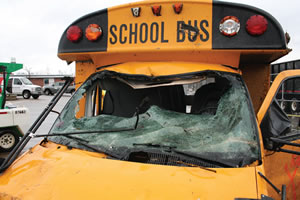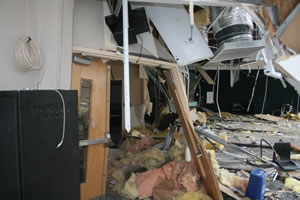Safety & Security (Prepare and Be Aware)
Preparing Schools for Natural Disasters
- By Michael Fickes
- 03/01/17

PHOTO COURTESY OF STEPHEN SATTERLY, JR., SOLE PROPRIETER AT SCHOOL SAFETY SHIELD, LLC, SCHOOL SAFETY SHIELD, LLC IUPUI SCHOOL OF PUBLIC AND ENVIRONMENTAL AFFAIRS, INDIANAPOLIS, INDIANA
In May of 2013, a half-mile wide tornado
roared through the Plaza Towers Elementary School in Moore,
Okla. Its 200-mph winds tore the school and the surrounding
community to shreds.
Like fires and some other kinds of natural disasters, tornados
come out of nowhere threatening and often taking lives. Brutal
winds ranging from 40 mph to over 300 mph will not only kill
people, they will destroy property. Raging winds can pick up cars,
as well as people, and toss them around like a child’s toys.
Hurricanes wreak havoc on lives and properties, too, but weather
forecasters can see hurricanes coming and predict their paths with
reasonable accuracy, allowing people at least a couple days to prepare.
In fact, it is a good idea for K-12 schools to
be prepared well ahead of any kind of disaster.
Then when something happens, administrators
and students can take cover immediately
in a shelter strong enough to protect lives for
days. Preparing for natural disasters involves
identifying risks and finding ways to remove
their sting. Preparations also include readying
shelters, warning everyone with alarms and
communications, setting up a system that will
enable a school to get back to teaching as quickly as possible.
Identify Risks
“Look at your region of the country and identify the kinds of
disasters that you might face,” says Michael Dorn, executive director
of the Juliette, Ga.-based Safe Havens International, the world’s
largest school safety center. “The two biggest risks are earthquakes
and tornados. Don’t ignore events because they are infrequent. For
instance, earthquakes are not common on the east coast, but they
have occurred there and they will again.
“Vet your list of risks with local or state emergency management
authorities. It is their job to know the risks. We emphasize
continual collaboration with emergency management people —
they will recommend components for your emergency plan as well
as drills appropriate to the region.”
Ready Shelters
Take some time to make sure the shelters chosen will provide
adequate protection. Some schools have been getting it wrong.
“The way many schools have drilled to prepare for tornados is
wrong,” says Paul Timm, vice president of RETA
Security, a division of Fairfax, Va.-based Facility
Engineering Associates. “They prepare by sending
students into the school’s hallways because the
walls there are reinforced.
“This was proven wrong in the Joplin, Mo.,
storm. In that storm, when the exterior doors gave
way, the hallways became wind tunnels and debris
was blown into the corridors from outside. Fortunately,
that storm hit over the weekend, and there
was no one in the building. Had there been students and teachers
sheltering in the hallways, they would have been mutilated.”
Where can people shelter safely? The answer, says Timm, is
the basement, if the facility has one. If not, move into the interior
rooms, rooms with no windows — in a school, interior rooms
typically include restrooms and locker rooms. Timm also notes
that K-12 schools are required to post evacuation maps that teachers
and students can refer to in the event of fire. “Our company
also recommends that these maps address severe weather by
designating shelter areas,” he says.
According to the 2015 International Building Codes, all new
schools must have tornado shelters built to FEMA specifications.
While the 2015 Codes are a couple years old, architects say that
many schools have not yet been brought into compliance with
these requirements.
Preparations Common
To All Kinds Of Natural Disasters
Students, teachers and people from the local community may
use schools as shelter for a different kinds of disasters: hurricanes,
floods, wildfires and so on. With that in mind, Timm suggests
keeping emergency supplies on hand in schools. “We recommend
Classroom Emergency Backpacks,” he says. “These backpacks have
supplies of food — specifically hypo-allergenic energy bars —
and water. They also have wind-up flashlights, which don’t need
batteries, thin, folded Mylar blankets, glow sticks, and first aid kits
with emergency medical supplies.
Don’t forget tents, continues Timm. Suppose an event destroys
a wing of the building with several classrooms. Tents can provide
temporary classrooms until building repairs are complete.
In addition to emergency supplies, it is important to drill for
natural disasters. While that may sound like too much trouble,
experts point out that K-12 schools have been drilling for fire
emergencies for decades now. And when there is a fire, students
as well as teachers have proven adept at getting out of the school
to safety.
“Drills are important,” says Timm. “In our state, Illinois, all public
and private K-12 schools are required to have one severe weather emergency
drill every year — in addition to fire evacuation drills, lockdown
drills and other drills that might be recommended.
“Invite police and fire department
personnel to your drills. They can advise
you about procedures and, equally important,
get to know your facility, which will
enable them to work more efficiently in an
emergency.”
Not all states mandate drills, but Timm
believes drilling is key to surviving a disaster
relatively unscathed.
Timm also helps schools organize
emergency table-top exercises for various
scenarios such as severe weather. Table-top
drills bring school emergency managers,
administrators, police and firefighters
together to discuss what they would do
to manage various emergency scenarios.
Another way table-top drills help is that
everyone at the table sees what each of the
others is going — so participants get more
than just their own angles.
One more option that some districts
have adopted is a short video, about
two minutes, that explains what to do
during an evacuation. Such videos are
particularly useful when regular drills are
impractical.
“You might also consider participating
in the Great American Shakeout,” says
Dorn. “This annual event teaches people
to protect themselves during an earthquake.
It has a standardized national
curriculum. Some of what you will learn
will also help to manage any liability that
may arise.”

PHOTO COURTESY OF STEPHEN SATTERLY, JR., SOLE PROPRIETER AT SCHOOL SAFETY SHIELD, LLC, SCHOOL SAFETY SHIELD, LLC IUPUI SCHOOL OF PUBLIC AND ENVIRONMENTAL AFFAIRS, INDIANAPOLIS, INDIANA
On March 2, 2012, a tornado caused significant damage to the Henryville High School in Henryville,
Ind. Students, who were sheltering in place inside the school, survived with nothing more serious
than minor cuts and bruises.
Timm advises reviewing emergency
plans periodically. “You really should
review your emergency plan a couple
times a year — a minimum of at least
once a year,” he says. “If you let it go past
12 months, you no longer have a living
document. Many components will still be
practical, but schools change and evolve
over time and the plan needs to take those
changes into account.”
Raising An Emergency Alarm
Fires and sudden severe stores require
quick action by everyone. School officials
must notify students and teachers and spur
an immediate reaction.
“Everything today is mass notification,”
says Timm. “That means I need several
communication vehicles. A midwestern
town, for instance, may have a tornado siren,
while buildings may notify occupants
through their public-address systems.
Some schools are installing emergency
message boards. Information about a
threat can be programmed to scroll across
these boards. If conditions are right to produce
a tornado, for instance, the boards on
campus might say: Tornado watch. Please
move to a safe area.
“These messages must get through to
everyone,” Timm says. “So you should use
as many ways to communicate as you have.
Other communication methods in use
today include texting and emailing to cell
phones, tablets and computers.
Maintaining Continuity
Getting through a natural disaster with
as few injuries and as little property damage
as possible is one part of emergency
management. Once the emergency ends, a
school must get back to teaching students.
Dorn calls this the Continuity Of Operations
Plan (COOP).
“Say an earthquake causes extensive
damage to a school,” Dorn explains. “The
emergency plan helps to keep people alive.
Next comes COOP. Suppose inspections
show that part of a building — or an
entire building — is out of commission. A
detailed COOP plan will address a variety
of physical and IT scenarios and problems
with solutions designed to return buildings
to service as quickly as possible.
Preparing for natural disasters ranks as
a vitally important task for school administrators
and staff. It requires taking stock
of risks facing a school in the event of a
flood, earthquake, fire or any other natural
disaster that might befall a school.
The preparatory thinking and work
is often assigned to the security director
and his or her staff. Experts recommend
that the security director lead the effort
by eliciting broad participation from the
administration, faculty, student body and
parents. In the end, disaster preparations
shared across the community will prove to
be highly effective when the time comes to
make use of them.
EVACUATING PEOPLE WITH DISABILITIES
When students, faculty and administrators evacuate a school,
just about everyone stands up and walks in orderly lines out of the
school, just as they did during regular drills.
Then again, not everyone can stand up and walk out. What about
people with disabilities? People in wheelchairs or on crutches can’t
simply walk out, and safety professionals ask that elevators not be used
in an emergency. People with disabilities need special help.
“Lift and carry can be dangerous,” says Jeff Wolvovsky of
EVAC+CHAIR North America LLC in Lake Success, N.Y.
EVAC+CHAIR manufactures special chairs that can be used to evacuate
the disabled. “On the bottom of our chair, there are reinforced rotating
belts,” Wolvovsky says. “When a person sits in the chair, the belts
rotate and glide down the stairs. Friction controls the speed of descent.
The heavier the person the more the chair brakes. Ninety percent of the
passenger’s weight is held by the stairway. Using our chair, a 100-pound
person can take a 250-pound person down the stairs.”
This article originally appeared in the issue of .